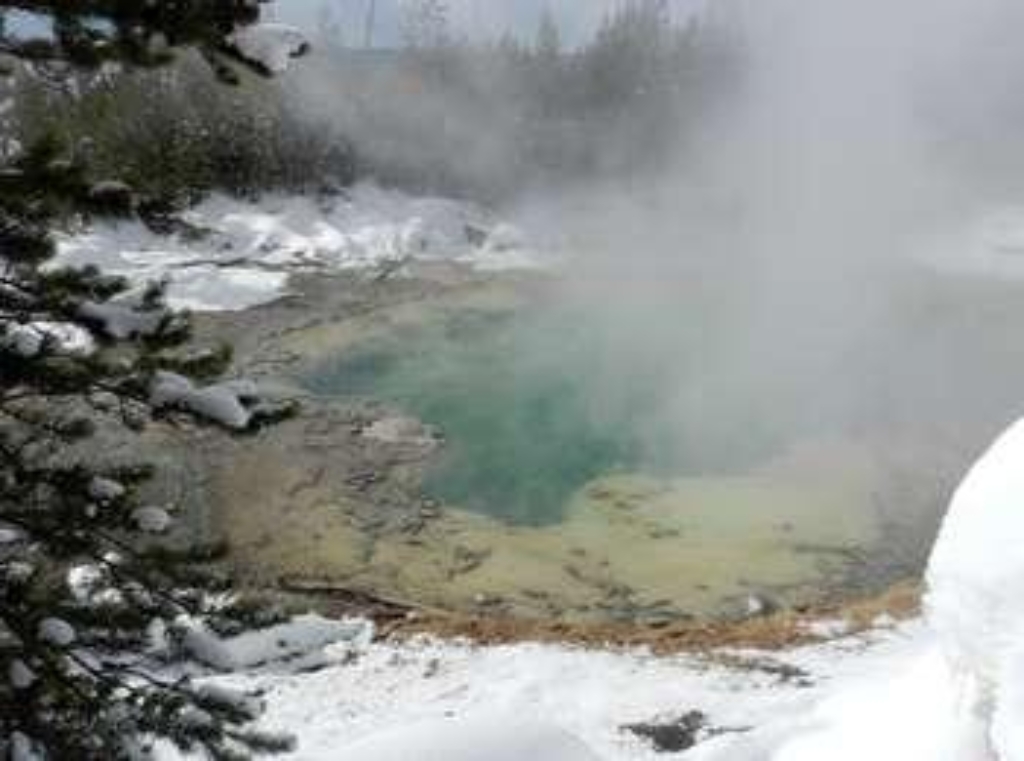
The color of Emerald Spring comes from the inherent blue of the water combined with the yellow of the sulfur-coated pool. The water in this 27-foot deep pool is so hot (close to boiling) that only the most heat-tolerant thermophiles can survive.
In sulfur-rich hot springs, such as Emerald Spring, some microorganisms use sulfur as their energy source. Byproducts from these reactions can be used by other microbes. This kind of “recycling” ties the various microorganisms into diverse functioning communities.
Hot Springs
Hot springs are the most common hydrothermal features in Yellowstone. Their plumbing has no constrictions.
Superheated water cools as it reaches the surface, sinks, and is replaced by hotter water from below.
This circulation prevents water from reaching the temperature needed to set off an eruption.
Color and Heat Lovers
Hydrothermal features are also habitats in which microscopic organisms survive and thrive. They are called thermophiles: "thermo" for heat and "phile" for lover.
Although they are too small to be seen with the naked eye, trillions are grouped together and appear as masses of color. They are nourished by energy and chemical building blocks.
Colorless and yellow thermophiles grow in the hottest water.
Orange, brown, and green thermophiles grow in cooler waters.
Imagine living in near-boiling temperatures, in hydrothermal features with the alkalinity of baking soda, or in water so acidic that it can burn holes in clothing. Microorganisms in Yellowstone need these extremes to survive.
Norris Geyser Basin
Norris Geyser Basin is one of the hottest and most acidic of Yellowstone’s hydrothermal areas. It is outside of the most recent Yellowstone caldera, but inside the first and largest caldera. It sits on the intersection of three major faults and is a very active earthquake area.
Each year, new hot springs and geysers appear while others become dormant. Geologic events trigger many of these changes. Even small earthquakes can alter hydrothermal behavior. This sudden activity is known as a “thermal disturbance” and can last a few days, or more than a week. Gradually, most features return to “normal.”
No one fully understands why this happens. Norris has the greatest water chemistry diversity among Yellowstone’s hydrothermal areas. The water chemistry changes as the water levels of underground hot water reservoirs fluctuates.
Although Norris is known for its acid features, it also have alkaline hot springs and geysers. As underground water and chemistry shift suddenly, they could contribute to dramatic changes in minerals and pH.
Use Caution in Hydrothermal Areas
- Stay on boardwalks and designated trails.
- Hydrothermal water can severely burn you.
- Never run, push, or shove.
- Supervise children at all times.
- Do not scratch hydrothermal mats.
You are responsible for your safety.
Think safety, act safely. Yellowstone is a dangerous place.
Is there something we missed for this itinerary?
Itineraries across USA


















































